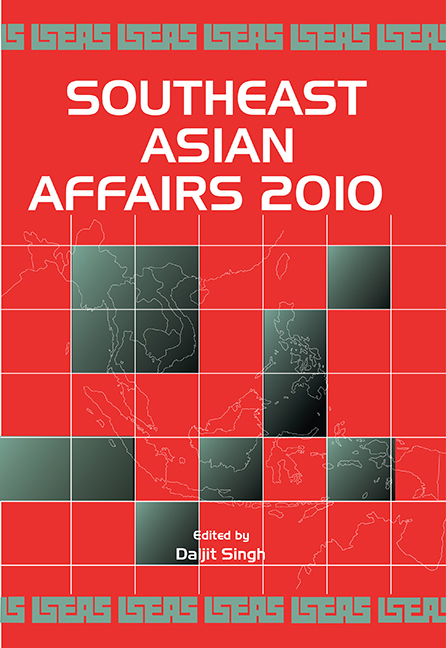Book contents
- Frontmatter
- Contents
- Foreword
- Introduction
- THE REGION
- Southeast Asia in 2009: A Year Fraught with Challenges
- Review of Southeast Asian Economic Developments
- The United States and China in Southeast Asia: Conflict or Convergence?
- The Year in ASEAN: The Charter, Trade Agreements, and the Global Economic Crisis
- BRUNEI DARUSSALAM
- CAMBODIA
- INDONESIA
- LAOS
- MALAYSIA
- MYANMAR
- THE PHILIPPINES
- SINGAPORE
- THAILAND
- TIMOR-LESTE
- VIETNAM
Review of Southeast Asian Economic Developments
from THE REGION
Published online by Cambridge University Press: 21 October 2015
- Frontmatter
- Contents
- Foreword
- Introduction
- THE REGION
- Southeast Asia in 2009: A Year Fraught with Challenges
- Review of Southeast Asian Economic Developments
- The United States and China in Southeast Asia: Conflict or Convergence?
- The Year in ASEAN: The Charter, Trade Agreements, and the Global Economic Crisis
- BRUNEI DARUSSALAM
- CAMBODIA
- INDONESIA
- LAOS
- MALAYSIA
- MYANMAR
- THE PHILIPPINES
- SINGAPORE
- THAILAND
- TIMOR-LESTE
- VIETNAM
Summary
Introduction and Summary
Southeast Asian economies are integrated into the world economy through multiple channels and remain sufficiently exposed to the G-3 (European Union, Japan, United States) economies that they could not escape a substantial hit from the global financial crisis. Our views can be summarized as follows:
• What is striking about the regional economies then was their surprising resilience — GDP growth is on track for a robust rebound, reversing the global impact fairly quickly. We believe that this improved resilience springs from important structural changes in the region since the Asian financial crisis of 1997–98. In particular, policy changes have strengthened macroeconomic frameworks and banking sectors while also allowing some degree of diversification of the economic base.
• The regional economies are thus poised for a strong rebound, even with a global environment that is likely to remain troubled and occasionally subject to financial stresses. However, these global level risks are not likely to result in a double-dip slowdown in Southeast Asia — external demand is recovering and the lagged effects of monetary and fiscal easing will support growth.
• The real challenge in Southeast Asia is to build economic resilience and prepare for a global economy that will be substantially different from the pre-crisis era.
Impact of the Global Crisis
(a) Global Crisis Hurt but Region Displayed More Resilience Than Expected
Two features of the performance of Southeast Asian economies in 2009 stand out: First, the crisis showed how intricately integrated the region is with the global economy and, in particular, with the United States, European Union, and Japan. Second, despite this, their economies have developed greater resilience to external shocks as seen in the speed with which their economies have rebounded.
As Table 1 shows, most Southeast Asian economies suffered a sharp deceleration in economic growth as the global crisis spread. However, the recovery came fairly quickly, meaning that the recessionary impact of the global crisis on Southeast Asia was mostly limited in duration.
This initially severe impact of the crisis suggests little evidence for the decoupling that many had hoped for.
- Type
- Chapter
- Information
- Southeast Asian Affairs 2010 , pp. 23 - 43Publisher: ISEAS–Yusof Ishak InstitutePrint publication year: 2010

